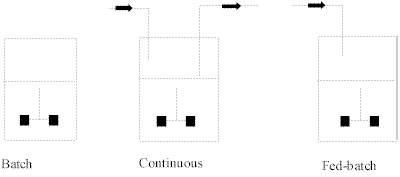
|
|
Bioreactors can be operated in three ways:

Batch reactors are simplest type of mode of reactor operation. In this mode, the reactor is filled with medium and the fermentation is allowed to proceed. When the fermentation has finished the contents are emptied for downstream processing. The reactor is then cleaned, re-filled, re-inoculated and the fermentation process starts again.
Continuous reactors: fresh media is continuously added and bioreactor fluid is continuously removed. As a result, cells continuously receive fresh medium and products and waste products and cells are continuously removed for processing. The reactor can thus be operated for long periods of time without having to be shut down. Continuous reactors can be many times more productive than batch reactors. This is partly due to the fact that the reactor does not have to be shut down as regularly and also due to the fact that the growth rate of the bacteria in the reactor can be more easily controlled and optimized. In addition, cells can also be immobilized in continuous reactors, to prevent their removal and thus further increase the productivity of these reactors.
The fed batch reactor is the most common type of reactor used in industry. In this reactor, fresh media is continuous or sometimes periodically added to the bioreactor but unlike a continuous reactor, there is no continuous removal. The fermenter is emptied or partially emptied when reactor is full or fermentation is finished. As with the continuous reactor, it is possible to achieve high productivities due to the fact that the growth rate of the cells can be optimized by controlling the flow rate of the feed entering the reactor.
History of Continuous Cultivation
Comparison
of Batch Culture and Continuous culture
![]()
Last modify: 05/01/2000, by Xuezhen Kang